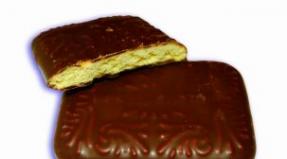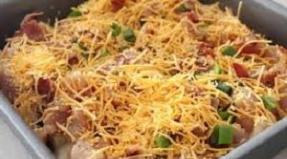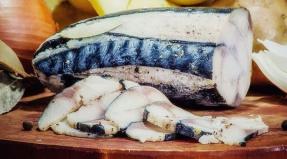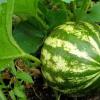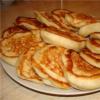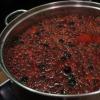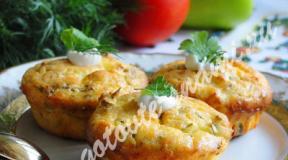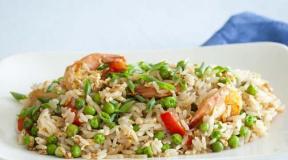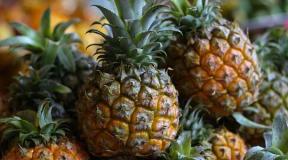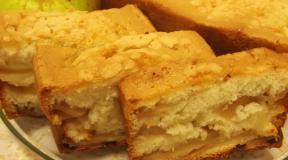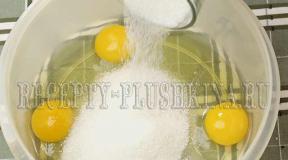How to make food coloring: recipes. What and how are natural food coloring agents made of red, yellow, orange, blue, purple, black, beige, white, green with their own hands? Mixing natural food colors: rules
When decorating cakes, pastries, cookies and other sweets, color plays a huge, one might even say key role. Therefore, having considered what the appearance will be, for example, of a cake, it is necessary to proceed to the coloring of the cream. You should immediately decide how many flowers you will use and divide the pre-prepared cream into this number of parts. We have already written about the fact that there are dyes of plant origin and synthetic. It is much easier to use synthetic ones, and often it is with the help of them that confectioners give the cream one color or another.
So, on the tip of a toothpick, take a scanty amount of dye, since it is in a very concentrated state, and immerse it in the cream. Stir the cream with a pastry spatula or spoon. If you need a complex color that requires the addition of another dye, then you need to introduce it with a clean (new) toothpick to avoid contamination of one dye with another. Next, it is necessary to stir the colored cream very thoroughly, until the color irregularity disappears.
Now a very important point- prepare a sufficient amount of cream (you can even with a small margin). You need to make sure that the colored cream you have prepared is sufficient to decorate your cake or other pastry. Remember that it is very difficult, almost impossible, to prepare the exact same shade as the one you did before, even if you are sure to remember the proportions of the dyes added to the cream.
  |
You can use a fairly simple technique to add a natural light effect or iridescent tints to your decorative elements. Using a brush, apply the concentrated dye of the desired colors to the walls of the pastry bag, from the end to the filling level of the bag with cream. Then, using a spatula, fill the bag in the usual way that we covered in the last lesson. Now, when you deposit the cream, the jewelry will turn out to be very interesting and attractive. Be sure to experiment with this trick and you will see how ingenious it is. |
 You don't need to have many jars with different shades to get any color. You just need to have three primary colors. With only three colors - blue, red, and yellow, you can get all the variety of colors. This palette clearly shows what colors are obtained when mixing the main ones. Red + blue = purple. Red + yellow = orange. Etc. You can also easily achieve different color saturations by varying the amount of dye added to the cream.
You don't need to have many jars with different shades to get any color. You just need to have three primary colors. With only three colors - blue, red, and yellow, you can get all the variety of colors. This palette clearly shows what colors are obtained when mixing the main ones. Red + blue = purple. Red + yellow = orange. Etc. You can also easily achieve different color saturations by varying the amount of dye added to the cream.
In conclusion, I would like to remind you of harmony. The color must be used very wisely to avoid clumsy and tastelessness. If you have doubts about which color combinations are harmonious and which are not, you can always find the answer just by looking around. Everything in nature is harmonious and beautiful. Nature is an eternal source of inspiration not only for artists, but also for confectioners, because it is not for nothing that confectionery is called art.
Pastries decorated with multi-colored cream are not only pleasing to the eye, but also whet the appetite. Often housewives add artificial colors to the cream, bought in the store.
However, the abuse of non-natural products can negatively affect health.
I suggest making dyes at home using the juice of some plants and other ingredients borrowed from nature.
Today you will learn how to make a green (or blue) cake cream and also learn how to make various natural dyes with your own hands.
How to decorate a cake with butter cream
Baking a cake for a significant event is not an easy task. But you can also cope with it if you show your imagination and follow the recommendations of the confectionery art guru. First, stock up on the ingredients you need.
50 g of condensed milk (made in accordance with GOST); 0.5 packs of butter (good quality); vanilla - a pinch.
Preparation:
- Soften the oil. You can cut it into pieces and leave it at room temperature for 40-50 minutes. Another way, it is faster, involves using a microwave oven, where the oil will be ready in 2-4 minutes.
- Using a mixer, beat the softened butter, not forgetting to add the vanillin.
- Pour the condensed milk in stages to obtain the required consistency. It is possible that the declared amount of condensed milk will be too much.
Condensed milk will give sweetness to the cake cream, but you need to work with the shade separately. If you want to give the cream a chocolate color, add cocoa powder.
The intensity of the color depends on the amount of powder, and it is in your power to change it both up and down.
The finished cream can be transferred to a pastry bag with a suitable attachment. But if it is not there, use the means at hand and build something similar.
For example, from a thick plastic bag. It is enough to fill it with cream and then cut off the corner.
You will get a small hole through which you will squeeze out blue or any other colored cream for dessert, making various inscriptions or other elements.
A rotating stand will be a good help in the work. You will not need to be distracted by turning the cake dish in different directions.
With a slight movement of your hand, you can quickly turn the dessert and apply the next element with the cream.
How to decorate a cake with protein cream
Decorations for a protein cream cake look no less beautiful and elegant. The main thing you need to remember is the absolute cleanliness of the dishes and utensils involved in the preparation of the cream.
First things first, separate the whites from the yolks. In order not to spoil the entire batch of eggs, break each unit over a clean cup, and only then pour the protein into a common bowl.
It is advisable to send the proteins to the refrigerator, they whisk better at a low temperature.
Wash the whisk and dishes in which you will whip the cream and pour over with boiling water.
The slightest traces of fat will not allow you to achieve splendor, which means that your efforts will be in vain. Drops of water on the dishes are also unacceptable; after processing, carefully wipe the bowl and whisk with a paper towel.
While whisking, add a pinch of salt and soda to the whites. This will save both time and energy. Plus, citric acid will make the mixture less sugary.
You can decorate the dessert with snow-white protein cream, it will look festive and elegant. Some confectioners prefer to paint the mass, because flowers in the natural environment are found in the most incredible shades.
What natural dyes can be made from at home
Taking into account consumer demand, professional pastry chefs decorate desserts with cream roses and different colored lettering.
Housewives can use store-bought blue dye in their kitchens. But is it so safe for health?
Let's turn to the experience of our grandmothers who managed to make dyes from available products. How and from what they did it, we will now figure it out.
The easiest and easiest way to color the cream is to add the boiled juice of some vegetables, berries or fruits to it.
It is known that the green color is obtained due to the presence of spinach juice, orange - carrots. Beets give red and turmeric yellow.
By combining colors with each other, you can get other shades. For example, by combining yellow and green dyes, you get a blue tint, which is also often used when decorating desserts.
Remember, beets will not give the cream a bright red color. Even if you boil it and mix the broth with a small amount of vinegar or citric acid, the result will be a brown hue or fuchsia color.
Finely chop the carrots before use and sauté for a few minutes in butter. After rubbing the mass through a sieve, add to the cream, and you get a carrot-colored decoration.
A rich orange hue will be given to you rather not by carrots, but by orange peel. You will be convinced of this when you rub a piece of sugar on the peel of this citrus.
Sugar crystals quickly absorb flavors and any color. Experiment with lemon, lime, and you will see how the sugar takes on a new color. By the way, orange color can be achieved using apricot boiled in syrup.
Turmeric, or rather its saturated aqueous solution, will make the cream not bright yellow, it will have a greenish tint.
If the decoration needs to be given a yellow sunny color, use saffron. An alternative to saffron would be sea buckthorn or pumpkin.
Red or deep pink color is obtained from fresh or frozen raspberries, cranberries or lingonberries.
Strawberries, despite their bright color, will give the cream an ugly brownish-red hue. Cherry juice mixed with cream will give it a cool red, with a purple tint, color scheme.
If you need a deep purple, inky rich dye, use blackberries.
And add blackcurrant syrup to the protein mass before baking, the result is a pale blue meringue.
A couple of drops of syrup will be enough to give the dessert a pleasant color. The saturation of the hue depends on the amount of dye, adding more than usual, you get a blue color.
Blueberries and blueberries will give you purple or cold lilac.
A delicate creamy shade is obtained by adding tomato paste. If you increase its concentration, the decoration from the cream will acquire a delicate orange tint.
Fear not, the dessert will not taste like tomatoes, the amount of dye is too small to affect anything other than color.
A shade of spring green will be presented by spinach, it is the leader among green natural dyes. It has a neutral taste, which means that your dessert, like before decorating with cream, will be sweet and thin out the vanilla aroma. Alternatives to spinach are tarragon (tarragon) and mint leaves.
Brown dye is cocoa powder, melted chocolate and saturated coffee solution (it can be either instant or ground).
How to make dyes at home
Syrups from various berries can be cooked in advance and kept in the refrigerator in a well-sealed container. If necessary, use to give the desired shade.
Frozen products are also used. You just need to defrost the berries, cover them with sugar (in a 1: 1 ratio) and boil over low heat. Strain the mass.
Rinse and chop the spinach. Pour in a little water and blanch for 5 minutes over low heat. Strain the green solution.
Peel and cut the beets. Boil 15-18 minutes in water and add a few crystals of citric acid. Use a strained solution.
You do not need to cook mint and tarragon, otherwise they will acquire a brown tint. First, prepare hot sugar syrup, add chopped herb to it and let it brew.
Chop pumpkin and carrots before use and sauté in butter.
When to add natural colors
Pumpkin, carrot, and saffron dye should not be added to the dough before baking (this does not apply to meringues and macaroons.
It is better to soak the finished cakes with syrup so that the dessert acquires the desired shade (green, blue, pink, red and others).
Natural colors are not added to the cream before whipping as they do not aid the process. Add them at the very end and in the amount necessary to obtain the desired shade.
Multi-colored dough for dumplings, ravioli are prepared with dyes previously dissolved in water. This is necessary for even distribution over the entire mass.
My video recipe
As a rule, visitors to restaurants and cafes pay attention not only to the taste of the dishes served, but also to how they are decorated. Therefore, the chefs try to decorate this or that dish as best as possible. Most of the attention in this case is paid to sweets and desserts. At home, you can also create various patterns from cream and sprinkles.
Your best bet is to learn how to make food coloring at home rather than buying it from the store. The result will be no worse, moreover, it is not dangerous to health. This homemade dye is used to color sauces, jellies, mastic, cream and more.
What are food colors?
Food colors are both synthetic and natural. In turn, synthetic are divided into liquid, dry and gel. diluted in a small amount of liquid to give the dish the desired shade.
Powdered dyes are diluted with boiled water, alcohol or vodka, and, if desired, are applied to baked goods in a dry form. Protein mass for creating patterns and creams, as a rule, are colored with liquid dyes. They are often used in airbrushes or sugar mastic as a substitute for water.

Liquid food coloring is very similar to gel color, but the latter is thicker and more concentrated. It is used in the coloring of creams (only non-protein ones), glaze, mastic and dough. With the help, you can create both delicate shades and rich and bright colors.
How to get natural red dye
Such a dye can be obtained using the juice of berries, fruits and vegetables that contain a red color, it can be:
- beet;
- Strawberry;
- currant;
- pomegranate and other food.
But red food coloring can be obtained from more than just fruits, try using dark red tomatoes, red peppers, and paprika powder for this purpose. Nevertheless, the most beautiful color comes from beets.
You can get red dye from beets as follows:
- Thoroughly wash the root vegetable under running water, peel, and then grate. Pour water over the beets. You don't need a lot of liquid, it should only cover the grated vegetable. Put on low heat and simmer for an hour.
- Please note that the pot must be covered with a lid. Add a little citric acid (1/2 teaspoon) to the broth, this will prevent it from fading. After cooling down, the red food coloring should be drained and then used.
How to make black food coloring
Black food coloring can be obtained in several ways:
- The first way. Mix five drops of purified glycerin with an activated charcoal tablet.

- The second way is how to make black food coloring at home. Black can be obtained by mixing several colors of artificial dyes. For example, take red, yellow, and blue food colors and mix thoroughly - you end up with black.
- The third way is how to make black food coloring at home. Take the cuttlefish ink. They are quite easy to get lately, they are sold in almost every large hypermarket. But despite the fact that the ink has practically no taste, there is still a certain specific taste, and therefore it is not recommended to use such a black food coloring for mastic or other sweet dishes.
How to make egg dye
Yellow food coloring (recipe): Add turmeric (3 tablespoons) to the boiling vinegar solution. Remember that turmeric stains the skin quite strongly, so be sure to wear rubber gloves before using this dye to protect your hands from staining.

Pink: Chop 4 cups raw beets and add them to the egg bowl. If the eggs at first seem to you not pink, but brown, do not be discouraged. Once dry, they will turn into a pleasant pastel shade.
To make food colors for blue eggs, add 3 cups of chopped purple or red cabbage to the solution. For the eggs to turn blue, they should be kept in the solution for half an hour. If you want to achieve a blue color, then put the eggs in the refrigerator and let them sit there in the solution all night.
Orange color: Onion skins (four cups) give the eggs a beautiful orange tint. To get a brighter color, then, as in the previous case, without removing the eggs from the dye, leave them in the refrigerator overnight.
DIY silvery food coloring: Place 2 cups of frozen blueberries in a container and add 2 cups of clean water to it. Wait for the mixture to warm to room temperature, then crush the berries. Let them stand a little longer, then strain the solution. Place the Easter eggs in the dye and refrigerate until morning.
Beige dye
To make a beige DIY food coloring, you should use tomato paste. The color saturation depends on the amount of this product, for example, if you add a lot of tomato to the cream, then it will become more orange than beige. Tomato paste does not change the taste of the dessert.

If you have prepared several different natural dyes in advance, then if you wish, you can create new colors from them. To do this, you just need to mix the existing ones. For example, to get aquamarine, you should mix two dyes: green and blue, and for a blue tint, add green to red. Mixing red, blue and green produces black. A beautiful pistachio shade can be achieved by mixing blue and yellow dyes.
Yellow
To color a dish yellow, chefs most often use lemon. Lemon zest is rubbed on a fine grater, and then juice is squeezed out of it, which turns into a liquid food coloring. Turmeric dissolved in warm water also gives a beautiful yellow tint.

Green color
Fresh spinach is most commonly used to achieve a rich green color. It is crushed in a meat grinder or rubbed through a sieve. Then the mixture is boiled for 30 minutes, after which it is filtered.
Blue and purple colors
These colors can be obtained from blueberries, dark grapes, or eggplant skins. You can also use purple cabbage for this purpose, which is pre-cut and boiled. With sugar, you can get a brown color. To do this, sugar is mixed with water (5: 1) and placed in a frying pan. Make a small fire and fry the sugar, remembering to stir it constantly. Gradually, the mixture begins to turn brown. Add some more water to it and strain. In addition to sugar, brown can be obtained using cocoa, coffee or chocolate.
Why are artificial colors harmful?
Today, a large number of artificial colors are produced, which are used in order to give an attractive appearance to dishes. But it is not always known what exactly is included in the composition of these synthetic dyes. It often happens that their composition can only be determined through long-term laboratory tests.

Manufacturers are not always ready to comply with standards, and often hazardous components in dyes exceed the permissible content. They can not only cause allergies in people, but also have a negative effect on the nervous system, cause oxygen starvation and, worst of all, provoke the formation of tumors. Therefore, it is better not to consume such products at all, but instead learn how to make food coloring at home.
Conclusion
There are two types of food colors: synthetic and natural. The first of them are most often made from chemical ingredients, so it is wiser to give preference to natural ones. Natural food colors are made from plant ingredients (usually fruits and vegetables).
You can create such dyes yourself at home and use them to decorate all kinds of dishes.
The right dessert pleases the eye and awakens the appetite by its mere appearance - just add a few bright colors. This is where colored creams for cakes without dyes come to the rescue.
From scratch
You can use a variety of products to decorate homemade cakes, pastries, and other pastries. The airy protein cream looks impressive and keeps its shape well. To prepare it, the egg whites are separated from the yolks, a pinch of salt, a little citric acid are added and whipped into a strong foam. Sugar or powdered sugar is gradually introduced into the resulting mass. Various oil creams are very popular. The simplest one is made from butter with the addition of egg yolks, powdered sugar and water. You can replace eggs with condensed milk, and you get an equally appetizing decoration. A very tasty and quick cream is made from sour cream with a fat content of at least 35%, powdered sugar and vanilla.
How to prepare a cream without dye for decorating a cake, or rather, without synthetic coloring additives? To do this, you need to research the stocks of food available in the kitchen, which will serve as natural dyes for us. Having processed them in a certain way and mixed with cream, you get an original colored cake decoration, delicious and absolutely harmless.
Sun on cake
The bright yellow color can be obtained in a variety of ways. The easiest is to add some fresh carrot juice or raw egg yolk to it. Saffron and turmeric have a rich yellow color. To make a natural dye out of them, you need to thoroughly grind the seasoning, dilute it in water and insist for a day. Then the mixture can be added to the cream. Lemon peel gives an iridescent yellow hue. To do this, grate it finely, wrap it in cheesecloth and squeeze the juice. Buckthorn juice can also be used as a natural coloring agent.
All shades of red

The persistent coloring properties of beets are well known. By adjusting the saturation of its juice, you can easily make an excellent cake without dyes at home, from pink to deep red. To do this, you need to grate a small beet, pour water over it and cook for an hour. To make the color intense and beautiful, add a pinch of citric acid to the broth. Do not forget about all kinds of red berries: raspberries, strawberries, lingonberries, currants, cranberries, dogwood. By the way, preserves, jams and syrups based on them can be used to create creams of red shades with the same success. Cherry and pomegranate juices will do the job just fine. And red wines will give the cake cream not only a pleasant color, but also exquisite aroma and taste notes.
Orange joy
Carrots not only have a rich orange color, but also generously share it with others. To do this, grate it and fry it a little in butter in a 1: 1 ratio. As soon as the carrots are sufficiently softened and the oil turns orange, remove the pan from the stove and let it cool. Next, we transfer the resulting mass to cheesecloth and squeeze thoroughly - the natural dye is ready. You can use an orange and color the cream with fresh citrus juice or crushed zest. You can also experiment with the already mentioned yellow and red dyes and mix them with each other.
Sweet coolness

How to make cold color cake cream? Blue and purple hues give the juice of blueberries, blackberries and dark rich grapes. A decoction of red cabbage leaves will produce light blue shades. Eggplant can be used as a coloring agent. First, you need to freeze them a little, carefully cut off the skin and squeeze the juice out of it.
There are many green vegetables, and spinach has the best coloring properties. Pass it through a meat grinder or wrap it in clean cheesecloth and squeeze it out, and you get a natural dye in a delicate green color. Looking for a more intense shade? Squeeze the juice out of the spinach and boil it for half an hour.
Chocolate palette
The easiest way to achieve a noble brown color is to mix the cream with regular coffee, cocoa powder, or melted chocolate. However, you can resort to a more sophisticated method - with the help of burnt sugar. For this, granulated sugar is diluted in water in a ratio of 5: 1, the mixture is poured into a frying pan and put on a small fire. We maintain the mass on the stove until it acquires a rich brown color. Then we remove it from the heat and pour in a little more water in a thin stream. Then we carefully filter the resulting dye. The main thing is not to overexpose the sugar, otherwise hard lumps will form in it.
As you can see, making a cream without dye for the cake is quite simple. And most importantly, you can do without harmful artificial additives. This decoration will surely please all your household members, especially the little sweets.
Natural food colors are easy, environmentally friendly and useful. 95% of information a person perceives with the help of his eyes, and making a dish brighter means making it more attractive. So, the juicy burgundy color of borscht or a multi-colored salad definitely stimulate the appetite. It is on this that the demand for food colors in cooking is based.
For thousands of years, people have successfully used the gifts of nature, extracting food colors from them. Now we have incomparably more opportunities for such research - let's see how you can prepare natural food colors at home and what requirements we set for them.
Requirement 1 - Natural colorant
Exclusively natural materials - extracts, pomace and juices, decoctions and tinctures from seeds and fruits of plants, from leaves and bark. Animal materials are not used to color food - because of their strong characteristic taste, because of the difficulty of obtaining and because of the short shelf life.
Requirement 2 - Food coloring means edible
This requirement implies not only the edibility of the dye, but also a minimum of its own taste. Ideally, the dye should be completely tasteless (onion peel) or add some zest along with the color (citrus zest or coffee). The taste of the colorant should not affect the taste of the final product, but this is difficult to implement in reality - and a separate problem when using natural colorants is the result of mixing flavors and aromas.
Requirement 3 - Coloring food
This requirement includes color stability and immutability - at least for a short time, although in these parameters natural dyes are definitely inferior to synthetic ones.
What to make natural food colors at home
.jpg) The beauty of natural food colors is their availability. These are products that we eat almost every day, familiar and healthy, inexpensive and accessible. Beets, carrots, spinach, spices, bright berries and citrus fruits - this is our rich arsenal at home.
The beauty of natural food colors is their availability. These are products that we eat almost every day, familiar and healthy, inexpensive and accessible. Beets, carrots, spinach, spices, bright berries and citrus fruits - this is our rich arsenal at home.
The answer to the question "from what to make natural food colors" is at hand at the hostess in every kitchen.
We can use:
1. Freshly squeezed juices from colored products.
2. Chopped and fried their pulp.
3. Direct addition of fresh pulp to the final product.
Feel free to focus on the original color of the vegetable or fruit: if the beets are dark red, then we will not get the orange or green dye from it. Accordingly, green spinach will not give us red dye, no matter what we do with it.
However, the same principles of mixing paints work with natural dyes as with watercolors, gouache or synthetic dyes. If you want an orange dye, mix red and yellow. Need green - mix yellow and blue food coloring.
How to get red food coloring and pink food coloring
Beets and fresh red berries (raspberries, lingonberries, cherries) are sources that help us to obtain red food coloring and food coloring pink.
Contrary to popular belief, beets will not give us a rich red color - depending on the concentration, we get shades from pale pink to burgundy. Grate fresh beets on a fine grater and simmer them in a little water over low heat. When the beets are quenched and “give off color”, squeeze the liquid through cheesecloth or a fine sieve. For a brighter, lasting color, add half a teaspoon of freshly squeezed lemon juice.
For pure red, use freshly squeezed lingonberry juice, but don't forget the characteristic sour taste.
Raspberry will give different shades of pinkish and raspberry, cherry - darker shades of red.
If you use these natural colors for your cream, a few drops of juice will be enough to add an interesting shade.
Dye blue natural food
The pleasant blues and blues are obtained with blueberries, blueberries or red cabbage. It is best to crush blueberries or blueberries in a sieve or mesh colander and add the resulting natural blue food coloring to the cream or dough.
Red cabbage juice produces an interesting blue or blue color. It is good to paint boiled egg white with this juice and decorate salads with it.
Yellow food coloring
Carrots, sea buckthorn, turmeric, saffron, citrus fruits give sunny shades of yellow and orange. Carrots are the most affordable option: grate bright carrots on a fine grater and fry them over low heat in vegetable oil. Squeeze the resulting gruel through cheesecloth or through a thick sieve.
Sea buckthorn juice can be added to creams or dough, it will give us the same cheerful yellow hue.
Turmeric can be found in any spice section and is a good option for yellow food coloring too. Pour a tablespoon of dry powder with warm water or alcohol, keep it in a dark place for 24 hours and strain. Turmeric is a budget saffron that doesn't taste so amazing, but it does very well as a food coloring.
Green food coloring
The soft green color comes from spinach. There are two options: - use freshly squeezed juice of leaves and stems - stew chopped spinach in water and then rub the gruel through a thick sieve.
Spinach green food coloring is often used to color dough.
Synthetic dyes and their invented harm
The consumption of dyes is growing from year to year, the requirements for the quality and safety of food paints are growing even faster - and manufacturers are simply forced to satisfy the needs of buyers.
Natural dyes are the prototypes for many synthetic dyes. So, for example, curcumin or carotene are almost identical in composition to natural ones. In addition, the quality and safety of synthetic food dyes is monitored by the WHO International Commission; all permitted for use are included in the Food Code - a code of standards for the quality of food and semi-finished products, which includes food additives.
Synthetic food additives are easier to use than natural ones, do not require preliminary preparation and special storage conditions, can be stored for a long time and will definitely not change the taste of cream or dough.
If you want to get not just pleasant shades, but bright natural colors - we offer you all types of food colors available today: dry, gel, liquid. .jpg)
.jpg)

Proven manufacturers, guaranteed fresh and high-quality products, a huge selection of useful and pleasant little things for cooking - the supermarket for pastry chefs will do everything to make the cooking process a real pleasure for you.
Read also ...
- Recipes for making coffee with ice cream at home
- Strawberry panna cotta - a classic of world culinary What is panna cotta with strawberries
- Cream of curd cheese for cake - the best recipes for impregnating and decorating dessert
- Profiterole recipe and three original custard recipes Protein cream for profiteroles
